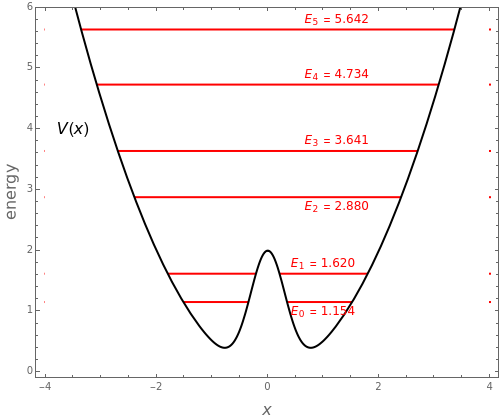Harmonic-Gaussian Double-Well Potential
Harmonic-Gaussian Double-Well Potential
A variant of a double-well potential is a harmonic oscillator perturbed by a Gaussian, represented by the potential . A similar function was used to model the inversion of the ammonia molecule [1]. The problem can be treated very efficiently using second-order perturbation theory based on the unperturbed harmonic oscillator. The first six energy levels are computed here.
V(x)=k+α
1
2
2
x
-β
2
x
e
The unperturbed Hamiltonian is =-+k. For convenience, we set . The unperturbed eigenfunctions are given by (x)=(x), where (x) are Hermite polynomials. The unperturbed eigenvalues are then =n+,n=0,1,2,…. The perturbation is the Gaussian function =β. To second-order in perturbation theory, we have =++-. (In practice, the sum is truncated at some ).
(0)
H
2
ℏ
2μ
2
d
d
2
x
1
2
2
x
ℏ=μ=k=1
ϕ
n
-1/2
(n!
n
2
π
)H
n
-2
2
x
H
n
(0)
E
n
1
2
(1)
H
-α
2
x
e
E
n
(0)
E
n
(1)
H
n,n
∞
∑
k≠n=0
(1)
H
n,k
(1)
H
k,n
(0)
E
n
(0)
E
k
n
max
When , the perturbation reduces to zero and the system reverts to a simple harmonic oscillator. As the central barrier becomes wider, the lower eigenvalues ( and ; also and ) approach degenerate pairs. The situation becomes similar to tunneling, giving two eigenstates of opposite parity, with their linear combinations approximating localized states.
α=0
n=0
n=1
n=2
n=3
